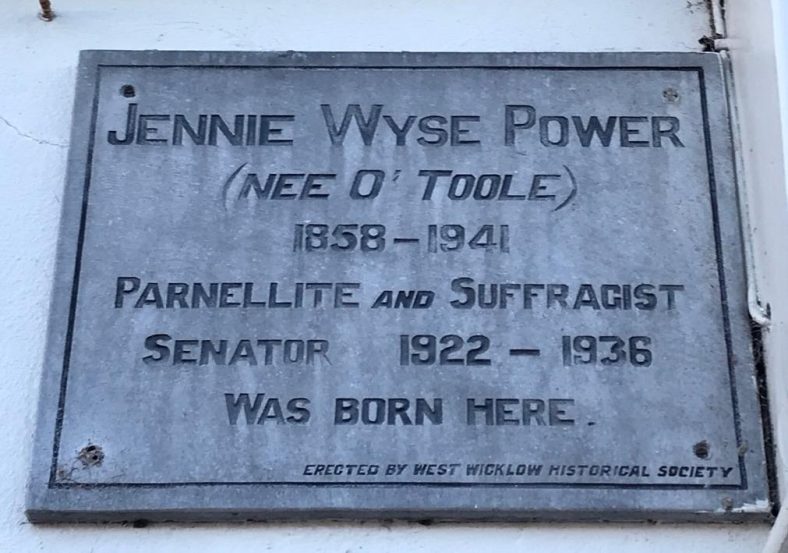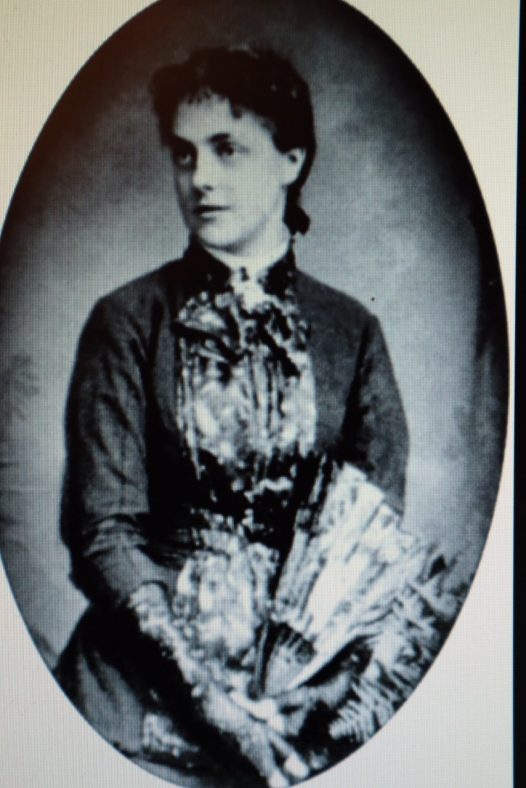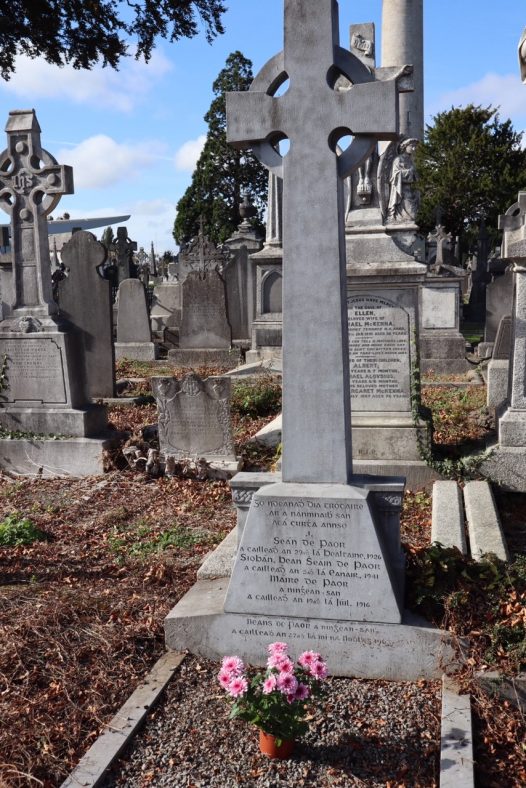The Wicklow connection and the early years
Jane O’Toole (who later became a household name as Jennie Wyse Power) was born at Main Street, Baltinglass, County Wicklow in the premises formerly known as Winnett’s Hotel on the 1st May 1858. Her parents were Edward O’Toole and Mary Norton both of whom hailed from farming backgrounds in the West Wicklow area, close to the Carlow border. The couple set up home in Baltinglass in 1841 where Edward established a leather, provisions and meal business on Main Street. The family lived upstairs over the business. Edward was also a small landowner at Shrughan, Baltinglass. Seven children were born to the couple: the youngest was named Jane, although she later became known and used the name ‘Jennie’. It is very fitting that a commemorative plaque has been erected by West Wicklow Historical Society to mark the birthplace of this remarkable Wicklow woman.

Plaque at Baltinglass
In 1860 when Jennie was just two years old, the family sold the Baltinglass business and property and relocated to Cuffe Street in Dublin where Edward again set up business. Jennie received a good education and presented as an articulate, self-assured young woman, very capable of holding her own in public debate. The O’Toole family were staunchly nationalist and made their home available as a safe haven to the Fenians. It is not surprising that the young Jennie grew up with strongly-held nationalist views. Sadly both her parents died by the time she was 20 years old. Jennie embarked on her first foray into the world of activism and politics in 1881 when she joined the Ladies Land League.
Political Awakening : The Ladies Land League
The Ladies Land League was founded in January 1881 by Anna Parnell, sister of Charles Stewart Parnell. This was not a feminist organisation but rather a body dedicated to challenging the landlord system and improving the lot of tenant farmers. The Ladies Land League was one of the first platforms to achieve the widespread politicisation of Irish women. Its main aim was to raise funds to provide relief to evicted tenants and in the event of the leaders of the Land League being arrested, to step in and carry on their work. Jennie O’Toole had many close relatives who were farmers in West Wicklow and she quickly became an active member of the executive committee. She soon found herself back in her native area, trudging through fields in wintry weather in order to reach the farms of distressed tenant farmers in Carlow and West Wicklow. Jennie chaired several meetings of local branches of the Ladies Land League and set up a new branch at Tinahely. By the beginning of 1882 the Ladies Land League had 500 branches across Ireland.

Jennie as a young woman
The activities of the Ladies Land League provoked controversy. It was attacked by the Archbishop of Dublin who accused its members of forgetting ‘the modesty of their sex and the high dignity of their womanhood’. These women were doing something very radical for the 1880’s: they were organising and operating effectively in the public sphere. However far from damaging the organisation, the Archbishop McCabe’s criticisms gave it new impetus and the movement continued to expand. Doctor Croke, bishop of Cashel rallied to defend the movement. The women were sometimes harassed by the authorities who eventually banned the organisation. However the defiant women continued to carry on the activities of the Land League after its leaders, including Charles Stewart Parnell, were imprisoned in October 1881. The ladies also stepped in to publish the banned Nationalist newspaper ‘United Ireland’. Their organisation was disbanded after 18 months following disagreements between Anna Parnell and her brother Charles. Jennie had become a close friend of Anna Parnell but remained neutral in the dispute between sister and brother. Young Jennie’s activism had catapulted her to the vanguard of Irish political life in just a few short years.
Wife, Mother, Parnellite and Businesswoman
One of Jennie’s many duties between 1881/83 included acting as librarian to imprisoned Land Leaguers and suspects held in Irish jails. It was about this time that she met a young man from Waterford named John Wyse Power. John had been arrested at Baltinglass in December 1881 for suspected Land League activities and was interned in Naas jail for a number of months. John also held strong nationalist views. He soon began working for the Leinster Leader and became its editor in June 1883. The couple married on 5 July 1883 and set up their first home at Naas. They had four children but sadly their first child Catherine died in infancy. John was one of the seven men who founded the Gaelic Athletic Association in Hayes Hotel, Thurles in 1884. The couple’s three other children were born between 1887 and 1892. The family moved from Naas to Dublin in 1885 when John obtained a post with the Freeman’s Journal. John was also a founder and first president of the county board of Dublin GAA (established October 1886). The Wyse Powers were ardent supporters of Parnell’s Home Rule movement and the Gaelic Revival. In 1890 Jennie joined Conradh na Gaeilge and became a member of its executive. The family often holidayed in the Ring Gaeltacht in John’s native Waterford, where in later years Jennie helped in setting up the Irish College.
The Wyse Powers declared their support for Parnell during the political crisis that erupted following the leader’s involvement in the O’Shea divorce case in 1890. The scandal caused a bitter split in the Irish Parliamentary party. The ‘Chief’ died suddenly in October 1891 and five months later Jennie and her husband named their only son Charles Stewart in memory of the dead leader. Charles Wyse Power went on to become a barrister and circuit court judge. The couple’s two daughters Maura and Nancy were also very successful. Maura became a renowned Celtic scholar and Nancy a senior civil servant and member of Cumann na mBan. In 1892 Jennie published ‘Words of the Dead Chief’, a collection of extracts from Parnell’s speeches. The couple became disillusioned with politics for a number of years after the Irish Parliamentary party split.
The Wyse Powers supported the Gaelic League, which was founded in 1893. Both John and Jennie learned Irish and they and their children participated in the various cultural activities of the League. The family relocated to 21 Henry Street in Dublin’s city centre about 1899 where Jennie set up her own business, calling it the ‘Irish Farm Produce Company’. This comprised a restaurant and a shop that sold farm produce, honey and cakes – all produced by Irish suppliers. Jennie’s ‘buy Irish’ stance was ahead of her time. Some of her supplies originated from her cousins in the Wicklow/Carlow area and were conveyed via the railway line from Baltinglass station. The pioneering business soon began to flourish with the family living upstairs over the shop. In time Jennie opened three further branches at Camden Street, Upper Leeson Street and Rathmines. Together with her husband John, Jennie formed one half of a talented and dynamic couple. The Henry Street restaurant soon became a meeting place for activists and nationalists. The Wyse Powers soon became well-known on the Dublin political scene. Indeed the Wyse Powers turn up in Chapter 12 of James Joyce’s ‘Ulysses’ as John Wyse Nolan and his bride.
Nationalist, Suffragist and Politician
In 1900 Jennie was elected one of the four Vice-Presidents of Maude Gonne’s Inghinidhe na hEireann (a title that her daughter Nancy described as ‘cumbersome’). This movement sought compIete independence for Ireland and development of the Irish economy and culture. It was formed to provide women with an activist platform, although it eventually merged with Cumann na mBan. The energetic Jennie was a life-long supporter of female suffrage. She was a member of the Dublin Women’s Suffrage Association, although she did not join the Irish Women’s Franchise League until 1914.In 1903 Jennie was elected as Poor Law Guardian for North Dublin, a public office she held for eight years. She was very critical of the Poor Law system under which she claimed ‘Irish money was misspent and the Irish poor demoralised’.
Sinn Fein was founded on 28 November 1905. Arthur Griffith became its first leader. Jennie became an executive member of the National Council of Sinn Fein in 1906. By 1911 she had risen to the position of Vice President, which meant that she ranked second only to Griffith in the organisation. Griffith expounded some original ideas which Jennie did not always agree with. He advocated abstention from parliament in Westminster and contended that the Irish members of parliament should leave the House of Commons and establish a native parliament in Dublin. It became Jennie’s view that the seeds of the eventual revolution were sown by Griffiths in these early years. Jennie continued to sit on the executive of this influential nationalist movement for a number of years. She later became the party’s treasurer. Griffith and other nationalists often used the restaurant at 21 Henry Street as their meeting place. In November 1913 the Irish Volunteers were established and soon became an armed military organisation. The women soon followed suit in 1914 by organising themselves as Cumann na mBan. Jennie was one of the founders and was unanimously elected as the organisation’s first president in 1915. Her daughter Nancy also became very active in Cumann na mBan.
The 1916 Rising
As a high ranking official in Cumann na mBan, Jennie was actively involved in preparations for the 1916 Rising. A room in the Wyse Power house was always available for use by the executive of the Volunteers. According to the memoirs of Kathleen Clarke, Tom Clarke’s widow, the Proclamation of the Irish Republic was signed at a meeting ‘held in Mrs Wyse Power’s house in Henry Street’ on Tuesday of Holy week 1916. A plaque was erected in 1991 to mark the 75th anniversary of the event. A number of high ranking rebels slept at and came and went from the Wyse Power home in the days approaching Easter week 1916, including Jennie’s friend Constance Markievicz.

Henry Street Plaque, Dublin
The Rising started on Easter Monday. The women of Cumann na mBan carried messages to and from the rebels around the city, provided food, first aid and safe houses. Jennie didn’t personally take up arms but she and her daughter Nancy carried food from the restaurant to the rebels in the GPO as late as the Wednesday of Easter week. One hundred members of Cumann na mBan were imprisoned following the Rising. Jennie and her family suffered a great deal in 1916. Their home and possessions were destroyed when 21 Henry Street was burned. They lost many colleagues and close friends who were either killed or imprisoned. Further tragedy struck in July 1916 when Jennie’s daughter Maura died from a lung disease at the age of twenty-eight.
The post 1916 period
In the period after the Rising Jennie provided aid to the families of Republican prisoners and she and her daughter helped to re-organise Cumann na mBan. The Irish Volunteer movement quickly grew to 600 branches nationwide. The 1918 General Election saw Sinn Fein win 73 out of the 105 available parliamentary seats. This was the first general election to take place since the Representation of the People Act 1918 had given the vote to women (albeit over the age of 30) and all men over the age of 21. Prior to this Act, all women and most men from working-class backgrounds had been excluded from voting. Constance Markievicz was elected for Sinn Fein with the assistance of Jennie and other members of Cumann na mBan, the Irish Women’s Franchise League and Irish Women’s Workers Union who had campaigned tirelessly for her. Sinn Fein decided against taking its seats at Westminster. Instead Dail Eireann was established, having its first meeting at the Mansion House on 21 January 1919. The authority of the new government was recognised over much of Ireland. Republican courts were set up in opposition to the Courts of the Crown. Jennie sat as one of the judges in North Dublin city. She became treasurer of Sinn Fein for a second time in late 1919 and sat on the executive council.
Jennie was elected as a member of Dublin Corporation in 1920. It had become her custom to sign herself in Irish as ‘Siobhan Bean an Phaoraigh’ and this was how her name appeared on the register. The council clerk took issue with this and held that because her name was not in English she was disqualified from taking her seat on the Corporation. Jennie challenged him and he was forced to back down. Kathleen Clarke who witnessed the row later wrote of Jennie that ‘she was an extremely clever woman and well able to defend herself…. I never admired any woman as I did her that day’. Jennie continued to assist the nationalist cause during the guerrilla war that became known as the War of Independence. She often provided safe refuge to men on the run from the British authorities.
The Treaty
The Treaty was signed on 6 December 1921 and caused Jennie much soul searching. She decided to support it because she perceived it as a pathway towards the achievement of greater independence. Jennie was the only leading member of Cumann na mBan to support the Treaty. As a result she was obliged to resign with regret from what she described as a ‘splendid force of women’. She was replaced as President of the organisation by Constance Markievicz. Jennie managed to retain some friendships with the anti-treaty women, although the impact of this rift cannot be under-estimated.
Jennie and other pro-treaty women recognised the need to create another platform from which to publicise their position and to aid in the establishment of the new state. Such a platform was created in March 1922 and called Cumann na Saoirse (The League for Freedom) and Jennie was elected onto the provisional committee. The country was plunged into a bloody civil war between June 1922 and May 1923 that divided Irish society for many decades to follow.
The Senator
Jennie was nominated by William T.Cosgrave as a member of the First Seanad which met in December 1922. She was sworn in on the same day as W.B. Yeats. She was also appointed as honorary Film Censor in 1922. After the General election of 1922 Jennie was elected Vice President of Cumann na nGaedeal, the new party formed by pro-treaty supporters. While in government this party established the institutions of the new Irish Free State. Jennie sat on a number of government sub-committees. When Dublin Corporation was abolished in 1924, Jennie was appointed as one of the three commissioners charged to run the capital. In her Senate debates Jennie exhibited a deep concern for the welfare of Irish women, especially their conditions of employment and housing. She objected in the strongest terms to the Civil Service Regulation (Amendment) Bill as she saw how it would discriminate against women. Over the years she became more and more disillusioned with the Cosgrave government, particularly with respect to its record on the Boundary Commission. In 1925 she quietly left Cumann na nGaedheal and continued for some years as an independent senator. Her husband John died in 1926. They had been married for 43 years. In 1934 she sat as a Fianna Fail senator. In spite of her busy life, Jennie found time to keep in touch with her Wicklow kinfolk in Baltinglass. Tinnaclash, Kiltegan is the resting place of many of her Wicklow relatives. Jennie continued to sit in the Senate until her retirement from public life in 1936. In later years Jennie published her recollections of Anna Parnell.

Senator Jennie Wyse Power
Reputation and legacy
Jennie Wyse Power’s passing on 5 January 1941 was mourned by both sides of the Irish political divide. The large attendance at her funeral included An Taoiseach and Mrs. de Valera, the Ceann Comhairle, several senior government ministers, senior civil servants, judges, senators and representatives from various women’s movements including Cumann na mBan. The huge turn-out for Jennie’s final journey is evidence of the enormous respect and fondness in which she was held. She is buried in the family plot in Glasnevin Cemetery, a stone’s throw from the graves of her former republican colleagues.

Jennie Wyse Power Grave at Glasnevin Cemetry
This energetic girl from Baltinglass became one of the best known, most capable and influential people of her generation. She operated at the forefront of Irish public life for over 40 of the most tumultuous years in the history of the nation. Her long public career was all the more remarkable because she combined it with a busy family life and business. She proved herself to be a pragmatic, outspoken and independent-minded politician who did not shy away from making difficult decisions.
The final word on Jennie Wyse Power must go to the historian Ann Matthews, who in the introduction to her 2010 book ‘Renegades: Irish Republican Women 1900-1922’, described her as ‘one of the most formidable and under-estimated women in nationalist history’.
Cora Crampton
West Wicklow Historical Society
October 2018
Sources:
Clarke, Kathleen and Litton Helen, ‘Revolutionary Woman: My Fight for Ireland’s Freedom’, Dublin 1991.
Dempsey, Jacqueline, ‘Jennie Wyse Power’, 1858-1941, National University Ireland Maynooth,1993.
Irish Times (1921-current file) for the account of Mrs. Wyse Power’s funeral on 8 January 1941.
Matthews, Ann, ‘Renegades – Irish Republican Women 1900-1922’,Dublin 2010.
McCoole, Sinead, ‘No Ordinary Women – Irish Female Activists in the Revolutionary Years 1900-1923’, Dublin 2003.
O’Neill, Marie, From ‘Parnell to De Valera – A Biography of Jennie Wyse Power 1858-1941’, Dublin 1991.
Power, Jane (Jennie) Wyse (nee Jane O’Toole) by Mary Cullen, in ‘Oxford Dictionary of National Biography’, 2004.
Ward, Margaret, ‘In their Own Voice: Women and Irish Nationalism’, Cork 1995.
Watkins, Sarah-Beth, ‘Ireland’s Suffragettes – The Women who fought for the Vote’, Dublin 2014.




No Comments
Add a comment about this page